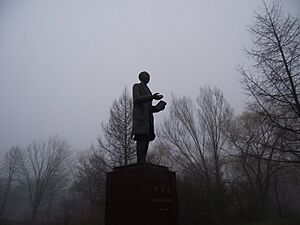Toronto Zoo facts for kids
 |
|

The main entrance to the Toronto Zoo in 2006
|
|
| Date opened | August 15, 1974 |
|---|---|
| Location | 361A Old Finch Avenue Toronto, Ontario M1B 5K7 |
| Land area | 287 hectares (710 acres) |
| Coordinates | 43°49′13.00″N 79°10′58.00″W / 43.8202778°N 79.1827778°W |
| No. of animals | 3,000+ |
| No. of species | 300+ |
| Annual visitors | 1.2 million (2022) |
| Memberships | WAZA, AZA |
The Toronto Zoo is a large zoo located in Toronto, Ontario, Canada. It covers a huge area of 287 hectares (about 709 acres), making it the biggest zoo in Canada! Around 1.2 million people visit the zoo every year.
The zoo is split into seven main areas, each showing animals from different parts of the world. These areas are Indo-Malaya, Africa, Americas, Tundra Trek, Australasia, Eurasia, and the Canadian Domain. Some animals live indoors in special buildings, while others are outside in spaces that look like their natural homes. You can see over 3,000 animals, including invertebrates and fish, from more than 300 different species. The Toronto Zoo is open every day of the year, except for December 25.
The City of Toronto owns the zoo. It was started by Hugh A. Crothers and John Cameron Egan. The zoo first opened on August 15, 1974, and was called the Metropolitan Toronto Zoo. The word "Metropolitan" was removed in 1998 when different parts of Toronto joined together to form the city we know today. The zoo is located near the Rouge River in the eastern part of Scarborough.
Contents
- Exploring the Toronto Zoo's History
- What Animals Live at the Toronto Zoo?
- Indo-Malaya: Animals from Asia
- Africa: The African Savanna and Rainforest
- Canadian Domain: North American Wildlife
- Americas: Animals from North and South America
- Tundra Trek: Arctic Animals
- Australasia: Down Under Animals
- Eurasia Wilds: European and Asian Species
- Discovery Zone: Fun and Learning for Kids
- Protecting Animals: Conservation Efforts
- The Toronto Zoo in Media
- See also
Exploring the Toronto Zoo's History
How the Toronto Zoo Started
Before the Toronto Zoo, there was a smaller zoo called the Riverdale Zoo. It opened in 1888. Animals were kept in small, dark cages, which was common for zoos back then.
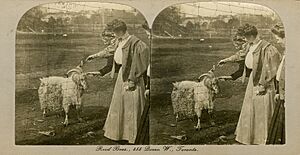
In 1963, a person named Hugh Crothers suggested building a new, modern zoo. He led a group of people who formed The Metro Toronto Zoological Society in 1966. They decided to build the new zoo in Rouge Park in Scarborough.
Construction began in 1970. On August 15, 1974, the Metropolitan Toronto Zoo officially opened. It was much bigger than the old Riverdale Zoo, growing from 3 hectares to 287 hectares. The new zoo was designed to give animals more natural environments and group them by where they live in the world. The old Riverdale Zoo became a farm called Riverdale Farm in 1978.
Key Moments Since Opening
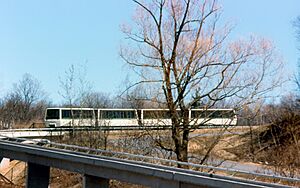
In 1976, the zoo launched the Canadian Domain Ride. This was like a monorail that took visitors through the Canadian Domain area. It stopped running in 1994 after an accident. Today, the zoo uses trams called Zoomobiles to move visitors around.
Many new exhibits were added between 1980 and 1984. These included homes for snow leopards and African elephants, and a children's zoo.
In 1985, two giant pandas, Qing Qing and Quan Quan, visited the zoo for three months from China. Thousands of people came to see them, setting new attendance records! Over the years, other rare animals have visited, like golden monkeys and koalas.
In 1998, the zoo changed its name to the Toronto Zoo. That same year, the Africa Savanna opened. This was the biggest expansion in the zoo's history.
The 2000s at the Zoo

In 2001, half of the Africa Pavilion became the Gorilla Rainforest. It has the world's largest indoor home for western lowland gorillas. In 2002, Splash Island opened, which is a fun water play area with an educational theme. A Kids Zoo opened in 2004.
In 2007, the Dinosaurs Alive exhibit opened, showing 18 moving dinosaur models. It was very popular. Also in 2007, the Tundra Trek area began construction. It would feature new homes for polar bears, reindeer, and Arctic wolves. The Tundra Trek opened in 2009.
Stingray Bay opened in 2008, letting visitors touch and feed live stingrays. This exhibit later closed to make space for the Giant Panda Research Center.
The 2010s at the Zoo
In 2010, the Frank Schofield Memorial / Asian Gardens opened. In 2011, a new exhibit for black-footed penguins opened.
In 2012, the zoo faced a challenge with its accreditation. This was because of a disagreement about sending its three elephants to a sanctuary that was not approved by the AZA. The zoo later got its AZA accreditation back. The elephants moved to the sanctuary in California in 2013.
In 2012, Canada arranged to borrow two giant pandas from China for ten years. The pandas, named Er Shun and Da Mao, arrived at the Toronto Zoo on March 25, 2013. Their exhibit opened in May 2013. In October 2015, Er Shun gave birth to twin cubs, Jia Panpan and Jia Yueyue. This was the first time giant pandas were born in Canada! The panda exhibit closed in March 2018 when the pandas moved to the Calgary Zoo.
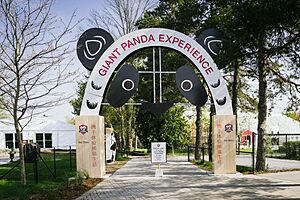
In December 2019, the zoo started a night walk experience called Terra Lumina. It shows a future where people live in harmony with wildlife.
The 2020s at the Zoo
The Toronto Zoo had to close several times starting in March 2020 due to the COVID-19 pandemic. Essential staff stayed to care for the animals. During one closure, a Masai giraffe calf was born. The zoo reopened for drive-through visits and later for walk-through guests.
In June 2023, a new outdoor home for Sumatran orangutans opened. This was the first time these orangutans could be seen outside their indoor building.
What Animals Live at the Toronto Zoo?
The Toronto Zoo is split into seven different areas. Each area shows animals and plants from that part of the world.
Indo-Malaya: Animals from Asia

The Indo-Malayan area has both outdoor spaces and a large building. It shows plants and animals from South and Southeast Asia. You can see Indian rhinoceroses, babirusas, Sumatran orangutans, false gharials, Sumatran tigers, and clouded leopards.
In 2023, a big outdoor orangutan exhibit was finished. This new space helps scientists learn more about how orangutans interact.
Africa: The African Savanna and Rainforest
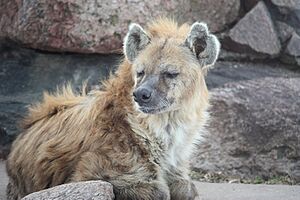
The African Savanna opened in 1998 and is the zoo's largest expansion. It covers most of the southern part of the zoo, along with the African Rainforest Pavilion. Here, you can find white lions, Grévy's zebras, cheetahs, white rhinoceroses, hippopotamuses, spotted hyenas, African penguins, and Masai giraffes.
The African Rainforest Pavilion has the world's largest indoor home for gorillas. It also features meerkats, red river hogs, dwarf crocodiles, and pygmy hippopotamuses.
Canadian Domain: North American Wildlife
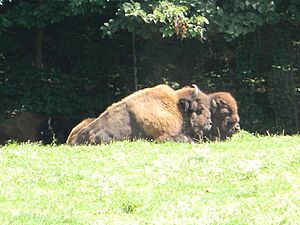
The Canadian Domain is located in the Rouge Valley. This area shows animals from North America in their natural surroundings. You can see wood bison, moose, cougars, bald eagles, raccoons, and grizzly bears.
Americas: Animals from North and South America

This area is home to animals from both North and South America. The Americas Pavilion has many different New World monkeys, amphibians, reptiles, fish, and insects. Popular animals here include white-faced sakis, golden lion tamarins, two-toed sloths, and river otters. The Mayan Temple Ruins part features capybaras, American flamingos, and jaguars.
Tundra Trek: Arctic Animals
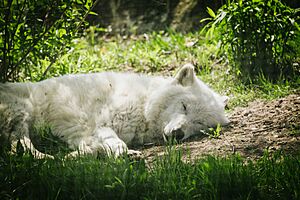
The Tundra Trek opened in 2009. It is the sixth main area of the zoo and shows many Arctic animals. You can see porcupine caribou, polar bears, snow geese, and Arctic wolves. The exhibits are very large to help the animals feel comfortable and encourage them to have babies. This area also teaches about the lives of the Inuit people and how climate change affects the Arctic.
Australasia: Down Under Animals
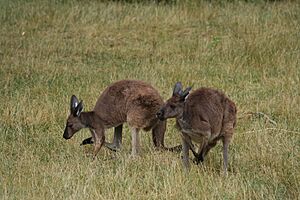
The Australasia Pavilion features animals from Australia and nearby islands. Here, you can find Western grey kangaroos, red-necked wallabies, short-beaked echidnas, southern hairy-nosed wombats, kookaburras, and Komodo dragons. The Komodo dragons were a gift from the President of Indonesia. This pavilion also has a Great Barrier Reef exhibit with seahorses, moon jellyfish, and colorful fish.
Eurasia Wilds: European and Asian Species

The Eurasia area is one of the oldest parts of the zoo. It was updated in 2014 and renamed the Eurasia Wilds. Animals here include snow leopards, Amur tigers, red pandas, and Bactrian camels. You can also see Steller's sea eagles. Some animals, like yak and Przewalski's horses, can only be seen from the Zoomobile.
From 2013 to 2018, the Eurasia Wilds was home to the two giant pandas, Er Shun and Da Mao. The zoo created a special Giant Panda Interpretive Centre to teach visitors about them. In 2015, Er Shun gave birth to twin cubs, Jia Panpan and Jia Yueyue, which was a very exciting event for the zoo and Canada!
Discovery Zone: Fun and Learning for Kids
The Discovery Zone is made for children with fun and educational exhibits. The main part is Splash Island, a water park that teaches about water. The Waterside Theatre is an outdoor stage where you can watch live animal shows with goats, grey crowned cranes, and macaws. The Kids Zoo has animals that children can interact with, like ferrets and skunks.
Protecting Animals: Conservation Efforts
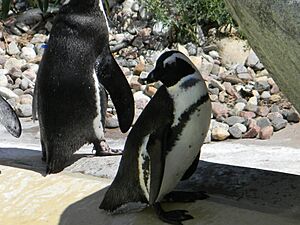
The Toronto Zoo works hard to protect endangered species from all over the world. They work with other zoos to help animals have babies in captivity. This is a big challenge, but the Toronto Zoo has been very successful. They have even helped release some animals back into the wild.
Here are some ways the Toronto Zoo helps with conservation:
- The zoo was the first to start a program to breed black-footed ferrets. They have released over 120 ferrets back into the wild.
- They have rescued polar bear cubs that were orphaned in the wild.
- The zoo studies a dangerous fungus that harms amphibians and reptiles.
- They help breed and release endangered Canadian animals like the Vancouver Island marmot and Blanding's turtle.
- The zoo also works to protect freshwater mussels in the Great Lakes.
- They help with international efforts to save animals like the Puerto Rican crested toad.
- The zoo collects and recycles cell phones. This helps protect gorilla habitats in Africa by reducing the need to mine a mineral called coltan.
The Toronto Zoo also takes part in Species Survival Plans. These plans help keep healthy groups of animals in zoos. This way, if a species becomes very rare in the wild, there are still animals that could be released back into their natural homes one day. The zoo has successfully bred many species, including western lowland gorillas, Sumatran orangutans, Sumatran tigers, snow leopards, and Komodo dragons. Many of these births were the first of their kind in Canada, North America, or even the world!
Notable Animal Births and Reproduction
The Toronto Zoo has celebrated many important animal births over the years:
- In 2003, the first Komodo dragon in Canada hatched at the zoo.
- In 2004, the first West African dwarf crocodiles in Canada hatched.
- Three Sumatran tigers were born in 2003, and two more in 2006.
- In 2006, three orangutans were born and named Jingga, Kembali, and Budi.
- Two rare snow leopards were born in 2007, the first in thirteen years. More were born in 2009 and 2017.
- Two Przewalski's horses were born in 2007, the first in fifteen years. More were born in 2008, 2009, and 2020.
- The zoo has also had success breeding Bactrian camels, with the most recent birth in 2023.
- In September 2015, four white lion cubs were born. They were the first pure-bred white lions born at the Toronto Zoo.
- On October 13, 2015, the visiting giant panda, Er Shun, gave birth to twin cubs, Jia Panpan and Jia Yueyue. This was the first time giant pandas were born in Canada!

- On November 11, 2015, a female polar bear cub named Juno was born.
- In February 2016, an Indian rhinoceros named Ashakiran gave birth to a male calf named Nandu.
- In May 2017, the Toronto Zoo had its first births of clouded leopards.
- In July 2017, a wood bison calf was born using a special embryo transfer method.
- On May 1, 2021, three Amur tiger cubs were born, with one surviving.
The Toronto Zoo in Media
The Toronto Zoo has been featured in many TV shows and videos:
- Zoo Diaries was a Canadian TV show that showed the relationships between animals and their keepers.
- Undercover Boss Canada filmed an episode at the Toronto Zoo in 2011 with the CEO.
- Rick Mercer Report featured Canadian comedian Rick Mercer visiting the zoo in 2008 and 2016.
- Many YouTube videos released by the zoo have become very popular. Videos of the giant panda Da Mao have been watched by millions.
- The zoo also has a podcast called Wild for Life where staff talk about their conservation work and animal care.
See also
 In Spanish: Zoológico de Toronto para niños
In Spanish: Zoológico de Toronto para niños
Other Toronto zoos and animal exhibits:
- Centreville Amusement Park – Far Enough Farm, a livestock zoo, on Toronto Islands
- High Park Zoo – small zoo in High Park run by donations
- Riverdale Farm – livestock zoo on site of former Toronto Zoo


